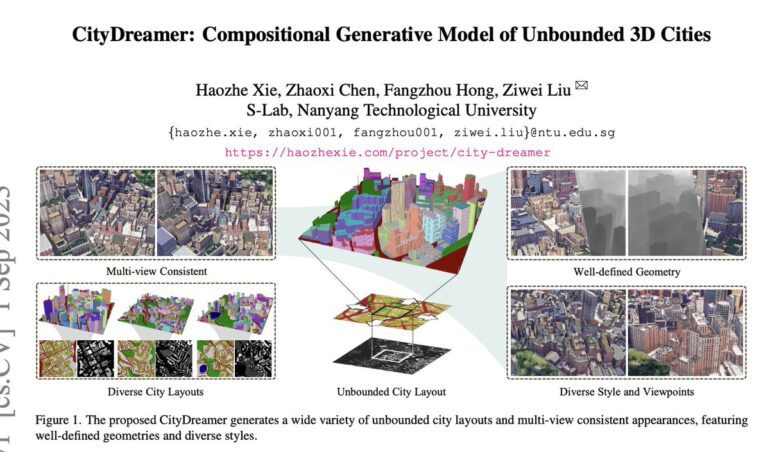TL;DR:
- Recent advancements in 3D natural settings research.
- Challenges in creating 3D cities due to diverse building appearances.
- CityDreamer: A unique model for realistic 3D cities.
- Division of building generation from background elements.
- Two datasets (OSM and GoogleEarth) for enhanced realism.
- Rigorous quantitative and qualitative evaluations validate CityDreamer’s superiority.
Main AI News:
In recent years, the realm of 3D natural environments has witnessed remarkable progress, marked by significant strides in crafting various 3D entities such as cities, scenarios, and avatars. Among these, cities hold a pivotal role, finding applications in urban planning, environmental simulations, and the realm of gaming. Notably, models like GANCraft and SceneDreamer have harnessed the potential of volumetric neural rendering algorithms, 3D coordinates, and semantic labels to create immersive 3D scenes, leveraging SPADE’s synthetic ground-truth images.
However, despite the burgeoning popularity of 3D natural landscapes, they are not without limitations. Creating 3D cities proves substantially more intricate than their natural counterparts. Buildings, though belonging to the same object class, exhibit a vastly broader spectrum of appearances compared to the uniformity found in natural elements like trees.
Enter CityDreamer, a groundbreaking compositional generative model engineered explicitly for unbounded 3D cityscapes. Its ingenious approach lies in segregating the generation of building instances from the myriad of background elements often found in cities, such as streets, parks, and water features. This distinctive division is made possible through a series of specialized modules integrated within the model.
To elevate the authenticity of generated 3D cities, two expansive datasets, namely OSM and GoogleEarth, have been meticulously curated. OSM, sourced from OpenStreetMap, enriches city layouts by offering semantic maps and height fields. These invaluable data sources provide critical insights into the spatial arrangement of roads, buildings, green spaces, and water bodies. On the other hand, GoogleEarth focuses on enhancing visual aesthetics, featuring images captured via Google Earth Studio, complete with multiview consistency. This combination results in a more comprehensive and lifelike portrayal of urban landscapes.
CityDreamer’s prowess has been rigorously scrutinized through both quantitative and qualitative evaluations. It has been benchmarked against state-of-the-art 3D generative models, showcasing its unparalleled ability to generate expansive and diverse 3D cityscapes. This achievement is particularly remarkable given the intricacies of urban environments and the demand for precise, high-quality outputs.
In summary, the CityDreamer project introduces a suite of innovations:
- CityDreamer Model: This groundbreaking model specializes in crafting unbounded 3D cities, uniquely segregating building generation from background elements, thus enabling precise control and enhanced realism in urban landscape generation.
- Construction of Datasets: Two datasets, OSM and GoogleEarth, have been meticulously compiled to enrich both city layouts and visual aesthetics. OSM provides critical data on city structures, while GoogleEarth enhances the visual appeal, resulting in lifelike urban environments.
- Quantitative and Qualitative Evaluation: CityDreamer’s performance has been subjected to comprehensive assessments, affirming its capability to outshine existing 3D generative models in crafting expansive and diverse 3D cities. This pioneering project redefines the landscape of urban 3D modeling.
Conclusion:
CityDreamer’s innovative approach to 3D city generation addresses the complexities of urban environments, setting a new standard for realism and precision. The ability to create diverse and expansive 3D cityscapes opens up exciting possibilities for industries such as urban planning, gaming, and environmental simulations, potentially revolutionizing the market by providing a more accessible and realistic solution for 3D city development.

